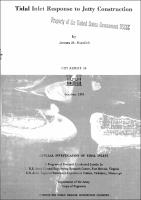Please use this identifier to cite or link to this item:
https://hdl.handle.net/11681/3227Full metadata record
| DC Field | Value | Language |
|---|---|---|
| dc.contributor.author | Kieslich, James M. | - |
| dc.date.accessioned | 2016-03-16T15:06:23Z | - |
| dc.date.available | 2016-03-16T15:06:23Z | - |
| dc.date.issued | 1981-10 | - |
| dc.identifier.uri | http://hdl.handle.net/11681/3227 | - |
| dc.description | General Investigation of Tidal Inlets Report | - |
| dc.publisher | Coastal Engineering Research Center (U.S.), General Investigation of Tidal Inlets Research Program | - |
| dc.publisher | Engineer Research and Development Center (U.S.) | - |
| dc.publisher | Abstract: Thirteen tidal inlets located on the Atlantic, Gulf, and Pacific coasts of the continental United States were selected for a study of the response of inlet ocean entrances to manmade improvements. Inlet entrance behavior following jetty construction were evaluated and guidelines for the functional design of inlet entrance improvements are suggested. The inlets considered in the study were those where a Single updrift or downdrift jetty was built first. The construction of single jetties at inlet entrances has resulted in migration of the channel thalweg toward the jetty regardless of the inlet-bay orientation, the jetty angle with the shoreline, the position of the jetty relative to the direction of net longshore sediment transport, the ratio of net-to-gross transport, or the gross transport. In some cases, this has caused undermining of the jetty. For the inlets studied, the annual channel thalweg migration averaged 31 percent of the total distance available for migration following construction of a single updrift jetty, and 49 percent of the total distance available for migration following construction of a single downdrift jetty. Accretion at the updrift shoreline and erosion at the downdrift shoreline usually followed construction of a single updrift jetty. Accretion rates at the updrift shoreline ranged up to about 800 feet (244 meters) per year. Data on erosion rates of the downdrift shoreline following construction of an updrift jetty were available for only a limited number of inlets. Sufficient information was not available to generalize the response of either adjacent shoreline following construction of a single downdrift jetty. The channel cross-sectional area usually decreased following construction of a single updrift jetty; the decrease in area ranging up to 40 percent. Sufficient data were not available to quantify channel area response following construction of a single downdrift jetty. | - |
| dc.relation | http://acwc.sdp.sirsi.net/client/en_US/search/asset/1004492 | - |
| dc.rights | Approved for Public Release, Distribution is Unlimited | - |
| dc.source | This Digital Resource was created from scans of the Print Resource | - |
| dc.subject | Channel Migration | - |
| dc.subject | Jetties | - |
| dc.subject | Longshore Sediment Transport | - |
| dc.subject | Tidal Inlets | - |
| dc.title | Tidal inlet response to jetty construction | - |
| dc.type | Report | - |
| Appears in Collections: | GITI Report | |
Files in This Item:
| File | Description | Size | Format | |
|---|---|---|---|---|
| GITI-R-19.pdf | 28.4 MB | Adobe PDF |  View/Open |